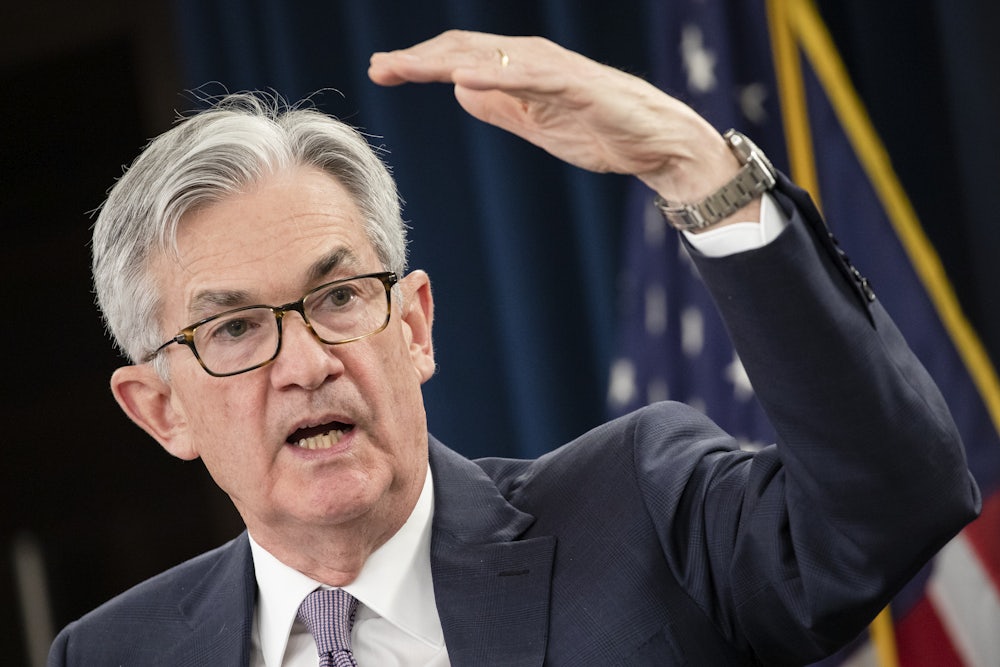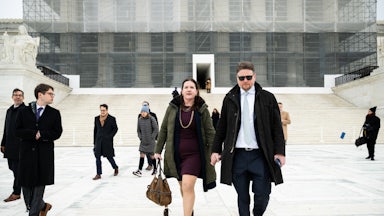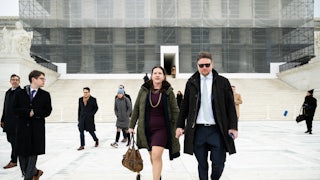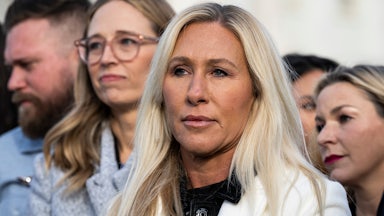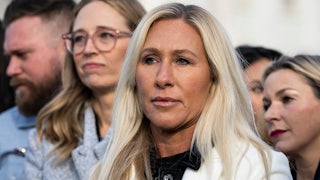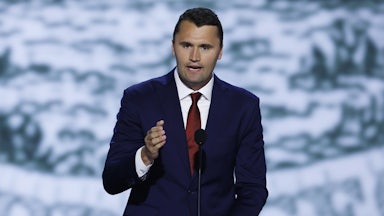When my daughter Alice was 6, she looked down at a roasted half-chicken on her plate, visualized it for the first time as the body of a once-living creature, and announced that she would henceforth be a vegetarian—“except for bacon.” I thought of Alice last Thursday when the Supreme Court ruled, in an unsigned emergency-docket opinion, that a president may fire any member of an independent federal agency—except at the Federal Reserve.
Alice gave up bacon about a year after her dinner-table pronunciamento, demonstrating the maxim, usually attributed to St. Ignatius of Loyola, that 7 is the age at which a child acquires the ability to reason. The median age of a Supreme Court justice is 66, so I don’t know what their excuse is. But if the high court follows Alice’s example, it will eventually have to concede that the president can fire the Fed chair too. I remain convinced that President Donald Trump will do so before Jerome Powell’s term ends in May 2026, and that the court will let him do it. I believe this because Trump has the impulse control of a toddler, and because the Supreme Court has painted itself into a corner.
Let me stipulate at the outset that I don’t expect the Supreme Court to uphold most of Trump’s outrageous power grabs. These have been so far beyond the pale that even Trump-appointed judges often rule against him. According to Bloomberg, “about 24 percent of federal district judges pausing or blocking the administration’s policies were appointed by Trump or other Republican presidents.” As of May 8, Bloomberg counted 329 lawsuits filed against Trump’s actions as president, with judges ruling against Trump in 128 cases and for him in 43. (In the remainder, no rulings are yet issued.)
But it was a given from the start that the Supreme Court would allow Trump to fire two Biden appointees—Gwynne Wilcox at the National Labor Relations Board and Cathy Harris at the Merit Systems Protection Board—whose terms weren’t due to expire until 2029. That’s because we’ve known for some time that there are five conservative justices ready to overturn Humphrey’s Executor v. United States (1935), a New Deal case that upheld statutory language making illegal any independent-agency firing without cause. The only surprise was that the conservative majority gave Wilcox and Harris the hook before it got around to overturning Humphrey’s Executor. It was acting, at the president’s request, against two district court judges and the District of Columbia Court of Appeals, which (following established law) reinstated Wilcox and Harris. The Supreme Court said its removal of Wilcox and Harris “reflects our judgment that the Government is likely to show that both the NLRB and MSPB exercise considerable executive power” that the Constitution vests in the president. Translation: Why wait? We know what we think before we hear any arguments.
The high court further said that “the Government faces greater risk of harm from an order allowing a removed officer to continue exercising the executive power than a wrongfully removed officer faces from being unable to perform her statutory duty.”
What “harm” to the government were they talking about?
Certainly Wilcox and Harris could be counted on not to create the kind of disruption that the Humphrey’s Executor plaintiff William E. Humphrey generated at the Federal Trade Commission when President Franklin Roosevelt tried to fire him back in 1933. Humphrey was a prize asshole who couldn’t get along even with his fellow Republican on the FTC, Abram Myers. “He reveled in personal and political attacks,” observed Marc Winerman, a former FTC lawyer, and William Kovacic, a former FTC chairman, in a 2011 article for the Antitrust Law Journal:
Alluding to socialism, he denounced as “pink” politicians who used the FTC to “persecute honest business.” When [Pennsylvania Governor] Gifford Pinchot questioned if the FTC could be trusted to investigate utilities, Humphrey (in an FTC press release) called the attack “regurgitated filth.”
You get the idea. Humphrey continued reporting to work after he was fired (a disruptive example today’s Democratic appointees might consider following), but he dropped dead the following year, which is why the case isn’t called Humphrey v. United States. (The case continued because Humphrey’s heirs sought back pay to the time of his death.)
The real harm the current Supreme Court had in mind last week was that the NLRB and MSPB, in reacquiring the quorum Wilcox’s and Harris’s removal denies, would resume the work that Congress assigned to these agencies, in 1935 and 1979 respectively, which was to protect the rights of private-sector workers and government whistleblowers.
The Trump court would appear to share its namesake’s preference that the NLRB and MSPB not function at all. Trump has yet to nominate anyone to fill two Republican vacancies on the NLRB and one on the MSPB. That’s nuts even from a conservative point of view, because until these agencies acquire a Republican-majority quorum they can’t overturn Biden-era regulations and administrative law precedents favorable to workers and whistleblowers. (See my February piece, “Trump’s Incompetence Is Botching His Own Deregulation Spree.”) The same logic applies to Trump’s firings of Democrats at the Federal Trade Commission and the Equal Employment Opportunity Commission, which similarly lack quorums as a result. (In these instances, though, Trump has nominated commissioners to fill Republican vacancies.) The Democratic firings at the FTC and the EEOC have prompted lawsuits similar to those filed by Wilcox and Harris.
Yet even as it permits Trump to trash most independent agencies, the Supreme Court draws a line at the Federal Reserve. Wilcox and Harris argued that if Trump could fire them, then he could also fire top officials at the Fed, causing potential economic calamity. (Sorry, make that more economic calamity.) “We disagree,” the Thursday ruling said, because “the Federal Reserve is a uniquely structured, quasi-private entity that follows in the distinct historical tradition of the First and Second Banks of the United States.”
This is an abbreviated version of the History Channel gibberish that Justices Sam Alito and Neil Gorsuch served up in their dissent in Consumer Financial Protection Bureau v. Community Financial Services Association (see page 21, footnote 16). Only now the Republican majority is pushing a little harder the idea that the “quasi-private” nature of the Fed (whatever that means) makes it different from other independent agencies. Tell that to the officials DOGE removed, with assistance from District of Columbia cops, from the United States Institute for Peace, a genuinely independent nonprofit funded by the federal government. (Last week, a judge ruled that this was, indeed, unlawful.)
Justice Elena Kagan, in a fine dissent also signed by Justices Sonia Sotomayor and Ketanji Brown Jackson, called bullshit on all this. “Our emergency docket,” Kagan wrote, “while fit for some things, should not be used to overrule or revise existing law.” Yes. On the purported harm from letting Wilcox and Harris return to their jobs, Kagan wrote: “What matters … is not that Wilcox and Harris would love to keep serving in their nifty jobs. What matters instead is that Congress provided for them to serve their full terms.” Yes.
Kagan also mocked the majority’s “bespoke Federal Reserve exception,” stating that “the Federal Reserve’s independence rests on the same constitutional and analytic foundations as that of the NLRB, MSPB, FTC, FCC, and so on—which is to say it rests largely on Humphrey’s.” Kagan added that “if the idea is to reassure the markets,” then the majority should have upheld Humphrey’s until the high court could actually rule on it. Markets really like to see civil order and the disinterested pursuit of justice! I don’t think the markets especially noticed Thursday’s ruling, but that’s only because they were too busy keeping abreast of Trump’s tariffs and research funding cutoffs and other gleeful sabotage of the economy. They’ll notice when Trump fires Powell.
